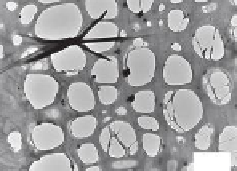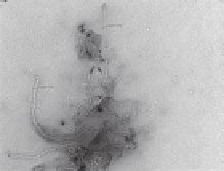Biomedical Engineering Reference
In-Depth Information
TABLE 18.1 (
continued
)
Areas for Detection and Identiication before Selective Quantiication Can Begin
Release Scenario
(Anticipated
Degradation
Mechanism)
Method to Simulate the
Lifecycle to Induce,
Detect, and Quantify
Release
Key Findings and Research
Needs
Morphology of Typical Released Fragments
Compounding by hot melt
extrusion
and
Combustion (thermal
degradation)
Commercial twin-screw
extruders, monitored by
CPC, SMPS, sampled for
TEM/SEM,
or
TGA (ISO 11358) with
off-gases monitored and
sampled
Fleury et al. (2013) conducted
extrusion of CNT-
acrylonitrile-butadiene-
styrene: complex polymer
fumes, no free CNT
At elevated temperatures,
polymer vaporizes and
re-condenses. Release of free
CNTs was observed for thermal
decomposition by TGA
(Bouillard et al. 2013) and for
dry-core drilling of CNT-epoxy
composites (Bello et al. 2010)
but not for extrusion of
CNT-polymer (Fleury et al.
2013)
Capacity to simulate real-world
scenarios needs to be validated
2
µ
m
Bouillard et al. (2013) found
that low-temperature
(400°C) combustion of the
same composite can release
CNT in lue gases
200 nm




Search WWH ::

Custom Search